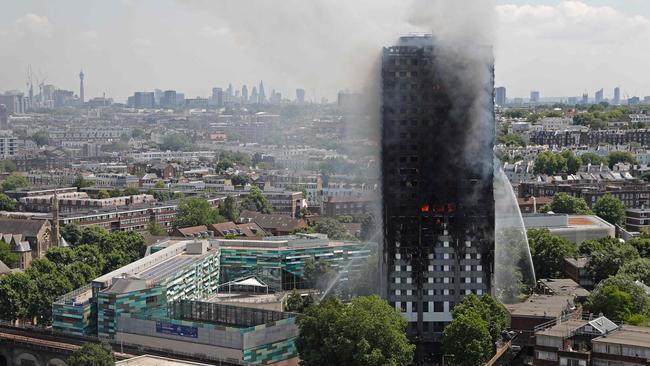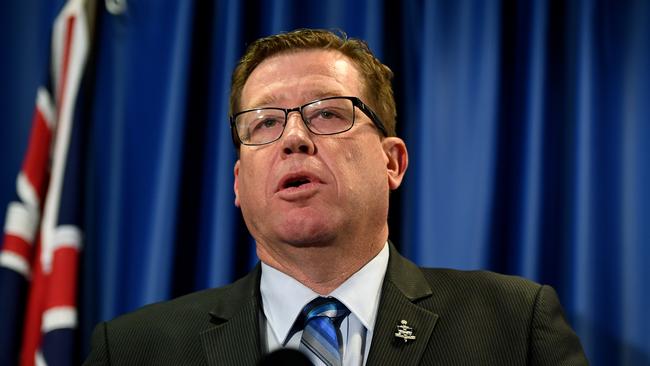Atlas Building in Norwest business park identified to contain potentially combustible cladding, 26 fire safety concerns
CLADDING that may be combustible has been identified as one of 26 fire safety issues in a commercial building in Sydney’s northwest — sparking urgent calls to fix the issues by Fire and Rescue NSW and a Sydney council.
- Proposal for Woolworths shopping centre undecided
- Who are the most influential people in your community?
CLADDING that may be combustible has been identified as one of 26 fire safety issues in a commercial building in Baulkham Hills — sparking urgent calls from Fire and Rescue NSW and the Hills Shire Council to fix the issues.
The commercial tower at 2 to 8 Brookhollow Ave, Baulkham Hills — known as the Atlas Building in Norwest Business Park — was inspected by FRNSW, following correspondence raising concerns around the inclusion of cladding on December 4, 2017.
FIRE SAFETY IN THE SPOTLIGHT
LAW FIRM QUESTIONS NSW GOVERNMENT CLADDING TASKFORCE
SYDNEY COUNCILS FAIL TO RESPOND TO TASKFORCE CLADDING
HILLS SHIRE COUNCIL PUSH FOR BETTER FIRE SAFETY PRECAUTIONS
The building at the entrance to Norwest Business Park includes companies such as Atlas Early Learning Centre, Virgin Active Gym, The Intentional Disciple Making Church and The Coffee Club.
In a Hills Shire Council meeting overnight, it was revealed that following the inspection, FRNSW called for council officers to inspect and address deficiencies on the site — resulting in the discovery of 26 fire safety concerns.
“On 30 October 2018, council officers inspected the premises and identified a number of fire
safety issues with the building,” a council report said.
“Given the significant risk to occupants, council staff has met the owners and their fire safety
contractor to discuss and have the smoke detection and alarm system and the fire hydrant system operational as a matter of urgency.

“As the number and scale of noncompliances identified is significant, it is warranted that a
fire safety audit of the premises be undertaken by an independent Accredited Fire
Safety Engineer or Accredited Certifier, to determine the level of fire safety in the building.”
When it came to the identification of potentially combustible cladding, a FRNSW report said the material is “located on the facade of the building and is near or directly above required exits”.
“If the building material is combustible and used as a finish, lining or attachment to a building … there is a risk that it may impair the fire-resistance level of the wall, compromise the safe evacuation of occupants from the building and lead to the spread of fire by way of the building facade,” the report said.
The report called for council to confirm whether the material is considered combustible and requires “further enforcement action”.

A Hills Shire Council review of the conduct of the building’s certifier, Lyall Dix from Dix Gardner, revealed The Building Professionals Board took disciplinary action against the certifier 12 times between March 2009 and November 2012 — when his accreditation was cancelled and he was issued a $50,000 fine.
“Furthermore, Mr Dix was disqualified from being an accredited certifier, director of, or being otherwise in involved in, the management of an accredited body corporate for 5 years and Mr Dix cannot reapply for accreditation for a period of 5 years,” the council report said.
“Mr Dix does not currently hold a Certificate of Accreditation with the Building Professionals
Board.”
Hills Shire councillor Alan Haselden said combustible cladding was a community wide problem that carries risk to life and he expected “many mare cases to come”.
“There is an observation that the private certification industry has failed,” Cr Haselden said.
“It is really alarming, and absolutely essential that reports like this surface and I would expect that this is in the public domain, the owners are aware of what we are concerned about.”
Developer Capital Corporation failed to respond to questions.
LIST OF FIRE SAFETY CONCERNS
-The use of potentially combustible external cladding
-Automatic smoke detector and alarm system was in fault and isolated,
-Alarm signalling equipment (sends signal to FRNSW advising of fire) failed,
-Smoke detector coverage not provided to all parts of the building,
-Smoke detector zone block plan does not reflect the actual building,
-Smoke detectors located within 400mm of air-handling systems,
-Fire hydrant pump crank isolated,
-Section of fire hydrant pipework from circulation relief valve missing,
-Fire hydrant pump not separated from the remainder of the building,
-Height in fire hydrant pump room less than 2.1m,
-Fire hydrant outlets located on levels they do not serve,
-Fire hydrant outlets are not provided with the required access and clearance,
-Sprinkler booster connections more than 1.2m from the ground,
-Sprinkler booster connections obstructed,
-Sprinklers in carpark obstructed,
-Some exit signs not operational,
-Exit signs directing occupants away from fire exits,
-Some emergency lighting not operational,
-Extended travel distances to a fire exit,
-Occupants must pass through a sole-occupancy unit to reach a required fire exit,
-Fire exits are not connected to a road or open space (ie. occupants would be stuck in a courtyard),
-Fire rated doorsets not self-closing or self-latching,
-Occupants discharging from fire exits are required to walk past unprotected windows,
-Fire hose reel coverage is not provided to all parts of the building,
-Unprotected penetrations through fire resisting construction,
-Annual fire safety statement displayed was out of date and numerous other noncompliances with the Building Code of Australia.



